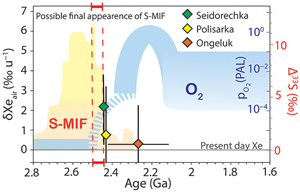Ardoin, L. ; Broadley, M.W. ; Almayrac, M. ; Avice, G. ; Byrne, D.J. ; Tarantola, A. ; Lepland, A. ; Salto, T. ; Komiya, T. ; Shibuya, T. ; Marty, B.
Geochemical Perspectives Letters, 2022, 20

Voir en ligne : https://doi.org/10.7185/geochemlet.2207
Abstract :
Noble gases are chemically inert and, as such, act as unique tracers of physical processes over geological timescales. The isotopic composition of atmospheric xenon, the heaviest stable noble gas, evolved following mass-dependent fractionation throughout the Hadean and Archaean aeons. This evolution appears to have ceased between 2.5 and 2.1 Ga, around the time of the Great Oxidation Event (GOE). The coincidental halting of atmospheric Xe evolution may provide further insights into the mechanisms affecting the atmosphere at the Archaean-Proterozoic transition. Here, we investigate the isotopic composition of Xe trapped in hydrothermal quartz from three formations around the GOE time period : Seidorechka and Polisarka (Imandra-Varzuga Greenstone Belt, Kola Craton, Russia) with ages of 2441 ± 1.6 Ma and 2434 ± 6.6 Ma, respectively, and Ongeluk (Kaapvaal Craton, South Africa) dated at 2114 ± 312 Ma (Ar-Ar age) with a host formation age of 2425.6 ± 2.6 Ma (upper bound). From these analyses we show that Xe isotope fractionation appears to have ceased during the time window delimited by the ages of the Seidorechka and Polisarka Formations, which is concomitant with the disappearance of mass-independent fractionation of sulfur isotopes (MIF-S) in the Kola Craton. The disappearance of Xe isotope fractionation in the geological record may be related to the rise in atmospheric oxygen and, thus, can provide new insights into the triggering mechanisms and timing of the GOE.



